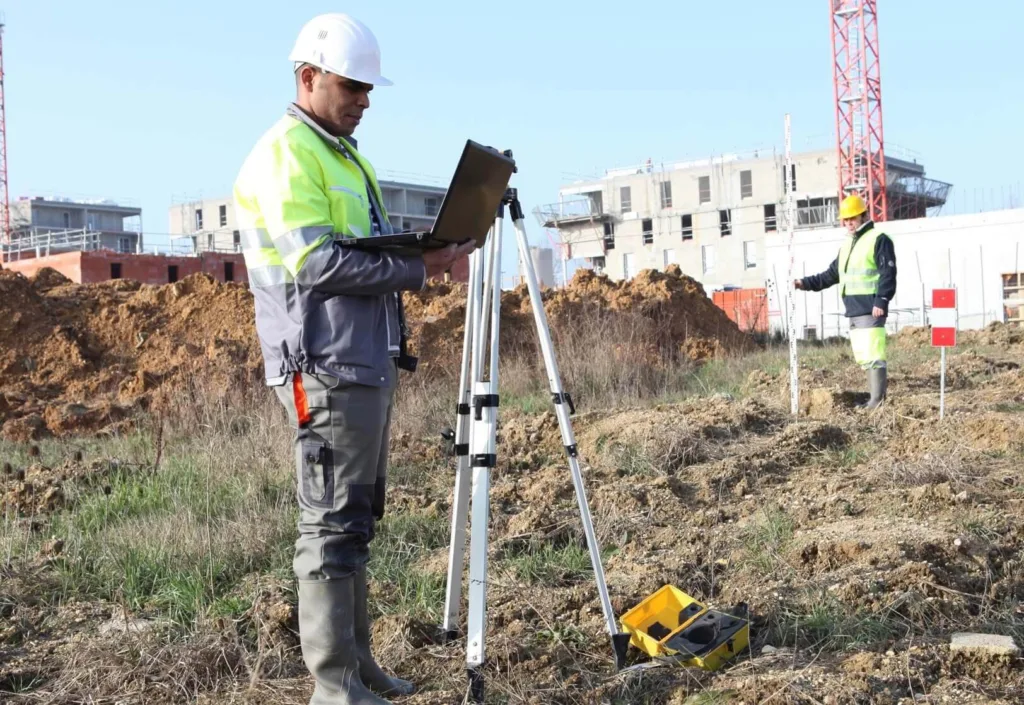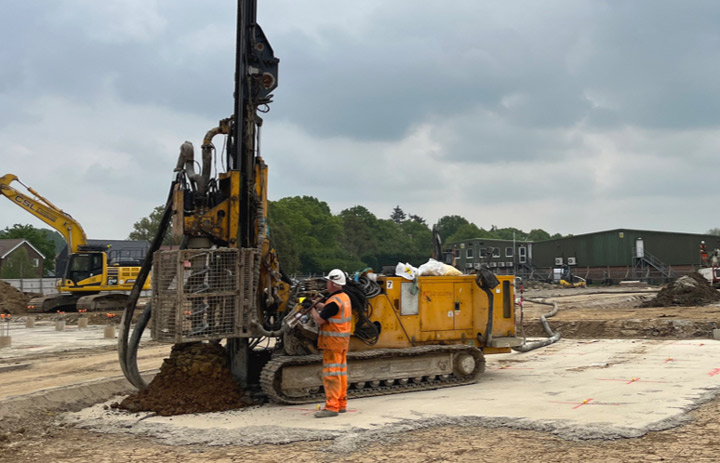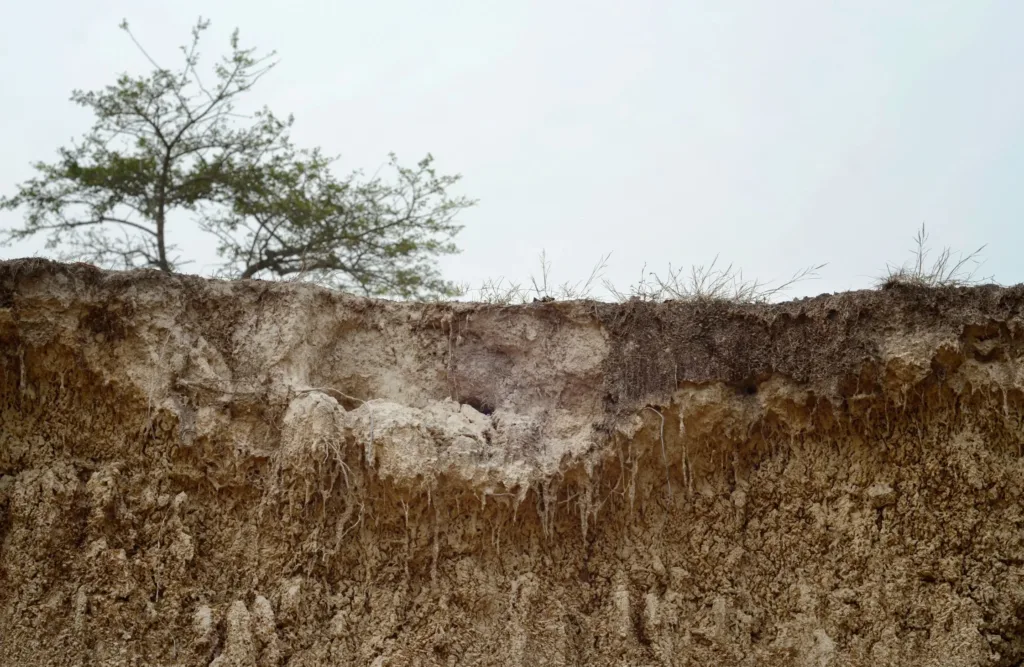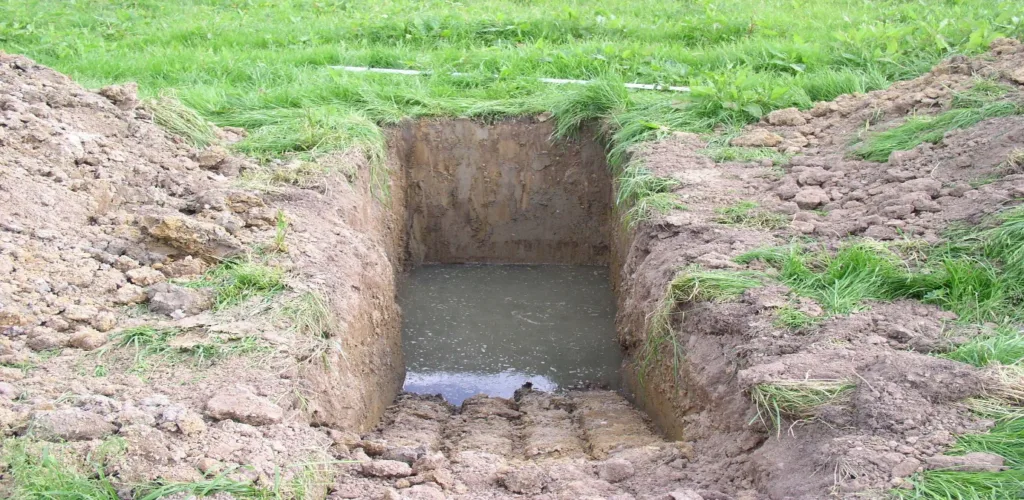Risks Associated with Dissolution Features in Chalk

Chalk dissolution diagram
The dissolution features found in chalk may pose a range of risks that can lead to severe damage to properties and infrastructure, particularly for the foundations of buildings. Even minor issues can still cause problems and be expensive to address, such as damage to services, facades, and renders.
Some areas are more susceptible to these risks than others, and managing these risks requires careful consideration and geotechnical engineering expertise to assess the potential impact on any structures affected.
Open Voids

A large open void
The thought of open voids underneath a structure can be unsettling, as the potential risks are concerning. These voids may create spaces within the geological structure that can compromise the stability of anything above them. Open voids can also cause issues with forming pile bores during construction, compromising safety and structural integrity whilst increasing costs and causing delays.
Detecting these voids can be a challenge, but with the advancement of technology, methods like geophysical surveys and penetration testing can verify their existence and location.
Ultimately, addressing open voids might involve filling them or designing foundations that bypass them. It’s essential to take measures to mitigate these risks as open voids can lead to disastrous collapses or difficulties in building foundations.
Infilled Features
Another potential challenge when building structures on chalk is the presence of infilled features, formed when voids or cavities collapse or become filled with sediment over time.
Infilled features can cause variations in the depth of the chalk, which can affect the capacity of the foundation. They can also represent soft spots in the ground, where the infill deposits have much lower strength than the surrounding chalk. This can result in irregular settling or movement of structures, potentially leading to structural damage.
To address this issue, designers can modify foundations to deal with the variability in the chalk depth or potentially remove the infill and replace it with a more stable material. By detecting and properly addressing infilled features, builders can ensure the safety and stability of structures on chalk foundations.
What Makes an Area Prone to Chalk Dissolution?
Chalk dissolution is largely influenced by environmental and geologic conditions, the main published methods for predicting this risk are thanks to work by Clive Edmunds (2001). Some factors that might make an area more prone to these features of chalk dissolution include:
- Rainfall and Weather: In areas with more rainfall, the water can infiltrate into the ground and interact with the chalk, leading to dissolution. Additionally, freeze-thaw cycles can also contribute to chalk dissolution.
- Soil Characteristics: The permeability and porosity of the soil can influence how water interacts with the underlying chalk. Highly permeable soils allow more water to reach the chalk, potentially leading to more dissolution.
- Underground Water Flow: The presence of underground streams or rivers can accelerate chalk dissolution by constantly bringing in fresh, slightly acidic water.
- Human Activities: Human activities, such as mining or construction, can accelerate chalk dissolution by disturbing the natural equilibrium of the environment and increasing the exposure of chalk to water.
Conversely, areas that have less permeable soils or thick protective cover by Paleogene deposits, and less human activity may be less prone to chalk dissolution features.
Ground Investigation Methods for Identifying the Risks with Chalk Dissolution

The initial identification of associated risks is crucial to navigating the complexities of chalk dissolution, which involves various techniques to understand the subsurface conditions.
Preliminary steps can include desk studies, site visits and non-intrusive ground testing. These direct the course of the ground investigation, shaping the selection of appropriate testing methods, the formulation of mitigation strategies, and the overall foundation scheme execution.
While specific methods of investigation might vary based on local geological conditions, common methods include: Geophysical Surveys, Cone Penetration Testing (CPT), Dynamic Probing, Borehole Drilling, Gamma Logging, Ground Penetrating Radar (GPR) or Laboratory Testing.
Before choosing a method, it’s essential to seek advice from geotechnical engineers or consultants, as the most effective investigation method can vary based on the local geology and specific project requirements. By conducting detailed investigations and analyses, experts can identify any potential issues or risks that could affect the foundation’s stability and offer solutions to mitigate them.
Keep in mind that this process should be iterative. As fresh data surfaces, the risk level should be reevaluated.
Mitigation Strategies for Foundation Design Where Chalk Dissolution is a Feature
Building a foundation in an area where chalk dissolution is prevalent can lead to unpredictable soil behaviour, making it essential to implement effective mitigation strategies during the design phase.
Reinforced Strip Foundations
Using reinforced deep strip foundations allows foundations to cover minor dissolution features, spanning these areas without compromising structural integrity. However, this approach may not address larger features, which could pose a risk without appropriate intervention.
While a Reinforced Strip Foundations method can offer protection, it can also be extremely expensive, particularly when used across a large development without careful targeting.
Engineered solutions can offer a more nuanced and cost-effective approach without compromising on safety or build-ability, and the potential shortfalls of reinforced deep strip foundations call for careful consideration and additional investigation to ensure larger features are properly identified and managed.
Piled or Piled Raft Foundations

SPEEDECK’s piled foundations
When it comes to building on soft ground or variable soil depths, piled or piled raft foundations are designed to mitigate the risks that come with such conditions. They do this by transferring the load of the structure to the piles.
Piled foundations involve driving or boring long columns deep into the ground, transferring building loads to greater depths. These are traditionally used with ground beams in housebuilding. A piled raft – essentially a combination of a traditional raft foundation and piles – spreads the load across a wider area for added stability.
However, as with any geotechnical solution, its success relies heavily on a thorough and detailed ground investigation. In the case of chalk, which may have weak zones at depth, a ground investigation will determine the best course of action and only through a comprehensive understanding of the ground conditions can an optimal pile design and layout be achieved.
Mitigating Risks for Piled Foundations

SPEEDECK constructing piled foundations
When building piled foundations on unstable ground, especially in areas presenting a high-risk scenario, one trusted methodology for site testing is to probe the pile positions.
Tools of choice for this are often Dynamic Probing and Cone Penetration Testing (CPT). Each has its strengths and brings a unique perspective to our understanding of the site conditions.
Armed with these investigations’ insights, we can make informed decisions on the foundation scheme, carefully calibrating our designs to respond to the site’s unique geological profile. The efficiency and value we gain from this process rests heavily on the quality of these investigations.
Dynamic Probing
Dynamic Probing is a widely used technique in ground investigation, due to its speed and low cost. However, it’s important to acknowledge that this technique is not faultless, and those aware of the limitations of dynamic probing are often hesitant to rely on it exclusively.
Based on our experience, Dynamic Probing can have a tendency to exaggerate potential risks, which can ultimately affect the outcome of a project. Additionally, while Super Heavy Dynamic Probing has its advantages, there are still some situations where it falls short. It can only distinguish between hard and soft ground, and the force with which it is driven means the investigation of very soft ground is quite insensitive. Therefore, it may not be able to accurately differentiate between open voids, infilled voids and heavily weathered Chalk.
The method can be useful to identify zones of potential weakness, however since the method often exaggerates the risk, further investigative work is often found to be needed. It may be the case that alternative approaches while seeming initially more expensive, could save more money overall.
Cone Penetration Testing

Diagram displaying how Cone Penetration Testing (CPT) works
Cone Penetration Testing is a highly valuable technique that provides a detailed understanding of ground conditions by measuring the strength of the ground the cone is pushed into. Its increased sensitivity particularly in soft materials is much better suited to identifying the true nature of dissolution features.
With the addition of a Gamma Probe sensor, sensitivity is further enhanced. This probe detects the low levels of natural gamma radiation emitted from clays, allowing for a more precise distinction between soil overlying the chalk and the identification of any infilled features.
This precision is particularly useful in the pile design process. If a CPT is carried out at each plot, piles can be designed on an individual basis, considering the conditions of their specific location. This is even more valuable if the depth of chalk varies greatly across the site and can lead to a highly optimised and efficient foundation design. For smaller developments, this approach can often prove to be the most cost-effective method.
However, for larger developments, conducting CPTs at every pile location can be time-consuming and potentially prohibitive in terms of cost. In these scenarios, geophysical investigations come into play. These non-destructive methods are adept at determining the physical properties of soil and rock, often used in environmental and engineering studies to map and characterise the subsurface without extensive drilling or excavation.
By identifying areas where potential features may occur, these Geophysical Surveys help target where CPTs would be most beneficial in time and cost-effectiveness.
Electrical Resistivity Imaging
Electrical resistivity imaging is a cutting-edge technology used in geophysical surveys. It’s particularly useful in identifying dissolution features. Electrical resistivity imaging detects variations in moisture content.
These variations are used to infer the presence of potential chalk dissolution features on a site. By targeting these areas specifically, the developers can ensure that any testing or excavation is carried out only where it’s necessary. Overall, electrical resistivity imaging is an invaluable tool for surveying and identifying features in challenging geological settings.
Another useful geophysical survey method for detecting possible features is magnetometry, which detects small changes in ground density. Both methods are viable but electrical resistivity imaging is likely to be quicker, especially for larger sites.

Diagram of electrical resistivity image
SPEEDECK’s Expertise: Navigating Challenges with Cone Penetration Testing

SPEEDECK on-site
A practical application of Cone Penetration Testing yielded illuminating results in a recent project undertaken by SPEEDECK, where Dynamic Probing initially suggested extensive dissolution features sprawling across significant parts of the site. These findings naturally provoked concerns and posed challenges for the planned construction work.
However, upon employing CPT, particularly enhanced with a Gamma Probe sensor, targeting the suspected feature areas, the assumed issues were not as severe as originally anticipated. The suspect areas, thought to contain open voids, were ultimately confirmed as zones of highly softened chalk or voids that had been infilled with soft silt.
In this case, the adoption of CPT provided much-needed confidence in our understanding of the ground conditions. This clarity was pivotal in shaping a successful piling operation and the construction work progressed efficiently, with no issues.
The instances where CPT transformed our comprehension of the ground conditions underline the value of this advanced technique in enhancing the safety and efficiency of our construction processes.
SPEEDECK Pile Raft System as an efficient foundation solution
At the cutting edge of geotechnical solutions, SPEEDECK’s piled raft system is a highly efficient solution for managing chalk dissolution risks. This advanced system is adeptly tailored to the unique challenges that variable ground conditions pose, demonstrating an impressive degree of flexibility and adaptability in the design of the foundation scheme.
One of the standout benefits of SPEEDECK’s piled raft system is its versatility. The piles can be strategically placed anywhere beneath the raft, allowing for a tailored approach to pile depth and location to accommodate site-specific ground conditions. This flexibility permits the scheme to efficiently respond to the varying nature of chalk dissolution features, facilitating the most optimal load distribution.

SPEEDECK Piled Raft constructed
Moreover, SPEEDECK’s piled raft system is designed with contingencies in mind. In the event of encountering unexpected voids during piling – a worst-case scenario in foundation construction – the system allows for the seamless addition of more piles to the raft. This flexibility to adapt on the fly eliminates the need for significant redesign or delays in the construction schedule.
SPEEDECK’s piled raft system embodies a balance of design engineering and practical adaptability. It is a reliable solution that not only acknowledges the uncertainties inherent in ground conditions but embraces and adapts to them, delivering an efficient, effective means of managing the risks for these developments.
Acknowledging Site Specificity and Embracing Expertise
The presence of chalk, while noteworthy, does not necessarily mean that there is an inherently high risk of dissolution features. It’s the unique combination of various geological features and site history that defines the level of risk. Engaging specialists early on is crucial. Their expert advice can guide further site testing and ensure that all associated risks are minimised or avoided altogether.
Remember, the historical context of a site also plays a pivotal role. In many areas, chalk has been mined historically, leading to the presence of man-made voids within the chalk. While this introduces another layer of complexity to the challenge, it is a topic deserving of its own detailed discussion, and we will explore this in a separate article focusing on mining risks.
In summary, while chalk dissolution presents a considerable challenge in foundation design and construction, with the right blend of comprehensive site investigation, expert input, and innovative solutions like SPEEDECK’s piled raft system, these risks can be effectively managed, paving the way for safe and successful construction projects.
Consider all the points discussed here and if you would like any more clarification, please do get in touch – our experts at SPEEDECK will be more than happy to provide informative advice tailored specifically to your needs.




